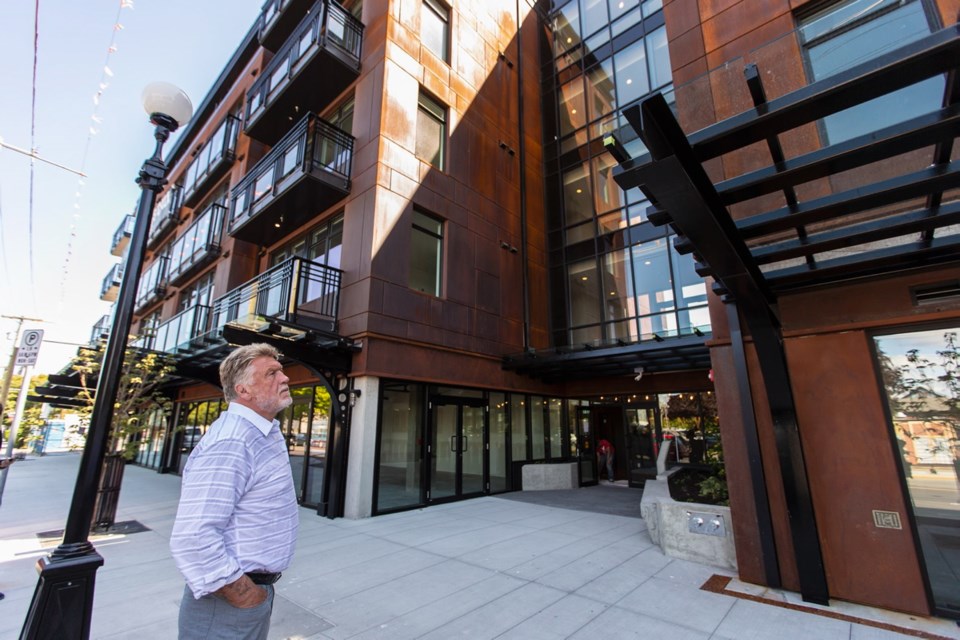Workers are repairing the old brick smokestack rising out of the historic Powerhouse building near Rock Bay.
The chimney project — costing hundreds of thousands of dollars — is part of an overall upgrade of the 1892 heritage building at 2110 Store St., purchased from B.C. Hydro by developer Chris Le Fevre.
It’s one of two projects Le Fevre is working on at the northern edge of Old Town. The other is his new Ironworks development, with 85 condominiums plus commercial space at Store and Chatham streets, across from Capital Iron.
The Powerhouse’s chimney was wrapped up for safety reasons and scaffolding has been installed. Le Fevre said it hasn’t been touched for decades, so a “substantial portion” of the masonry is being rebuilt.
He would not be specific, but said the cost to remediate the 20,000-square-foot building is several million dollars.
The former industrial building is now rented by Metropol Industries, which specializes in printing and marketing. Le Fevre said work on the exterior of the Powerhouse, and “cleaning the building up,” has been ongoing for nearly a year.
Le Fevre first built an access road into the property, required by the city for the Powerhouse to be subdivided from the adjacent B.C. Hydro lands.
The Powerhouse was constructed to a high industrial standard. Le Fevre calls it the most rugged heritage building he has worked with. “The reason is that it was built originally as a blast-proof building because it was generating power with generators.”
It was designed by architect and former mayor John Teague — who also designed Victoria City Hall — and is listed on the federal-provincial register of Canada’s historic places.
“The value of this building lies in its solid purpose-built form, simple Romanesque detailing, and large, open interior spaces,” says the register. “This powerhouse is an edifice in the Upper Harbour industrial area, and contributes to the diversification of Victoria’s architectural heritage.”
Built as a steam-generating plant, the Powerhouse provided power for the city’s newly electrified street lights and the city’s early trams, the register says. “It facilitated the modernization of the city as it grew in the late 19th and early 20th centuries.”
Just to the south, Le Fevre’s five-storey Ironworks development at Store and Chatham streets has been completed. It is the first phase of Ironworks, with a second stage of a similar size planned.
The name and the rust-coloured corten exterior of Ironworks were chosen to reflect the area’s industrial past.
The former Albion Iron Works was on Chatham Street and the Capital Iron building across the street was originally a marine-scrap business. Le Fevre said he spotted rusted metal on the landscape when he was riding his motorcycle in the high desert in California, and decided that kind of look would suit the exterior of his Ironworks project.
The first occupants move into Ironworks in early August. The project was 60 per cent pre-sold and remaining units are going on the market in a couple of weeks, he said.
Commercial space will likely be taken up by a restaurant, coffee shops and smaller food-service outlets.
Le Fevre has redeveloped more than 10 Old Town buildings, repurposing often rundown structures for residential and commercial uses.
After 17 years, he is nearing completion on his Railyards development on the north side of the Point Ellice Bridge. Construction starts next year on the final building, featuring townhouses and micro-sized affordable units. Once that’s finished, about 400 homes will have been constructed in the Railyards.
Le Fevre has other projects underway, including townhouses in Ucluelet, as well as townhouses and commercial space in Revelstoke’s historic district. He has also purchased more than 600 acres in Landers and the Joshua Tree area in California, where he plans to build small homes.



